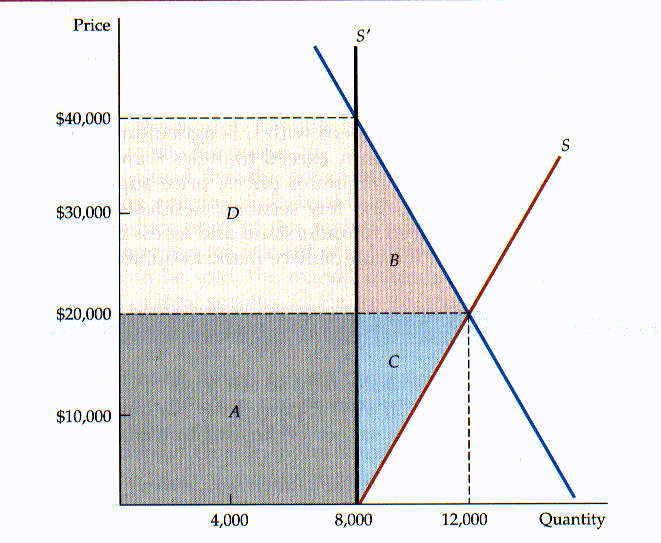
The market for human kidneys
Should people have the tight to sell parts of their bodies? Congress believes the answer is no. In 1984 it passed the National Organ Transplantation Act, which prohibits the sale of organs for transplantation. Organs may only be donated.
Although the law prohibits their sale, it does not make organs valueless. Instead, it prevents those who supply organs (living persons or the families of the deceased) from reaping their economic value. It also creates a shortage of organs. Each year about 8000 kidneys, 20,000 corneas, and 1200 hearts are transplanted in the United States, but there is considerable excess demand for these organs, and many potential recipients must do without them. Some potential recipients die as a result.
To understand the effects of this law, let's consider the supply and demand for kidneys. First the supply curve. Even at a price of zero (the effective price under the 1984 act), donors supply about 8000 kidneys per year But many other people who need kidney transplants cannot obtain them because of a lack of donors. It has been estimated that 4000 more kidneys would be supplied if the price were $20,000. This implies the following linear supply curve:2

First consider suppliers. Those who provide kidneys fail to receive the $20,000 each kidney is worth, a loss of surplus represented by rectangle A, and equal to (8000)($20,000) = $160 million. Also, some people who would supply kidneys if they were paid for them do not, and they lose an amount of surplus represented by triangle C, and equal to (¼)(4000)($20,000) = $40 million. So the total loss to suppliers is $200 million.
What about recipients? Presumably the 1984 act intended to treat the kidney as a gift to the recipient. In this case, those recipients who obtain kidneys gain rectangle A ($160 million) because they do not have to pay the $20,000. Those who cannot obtain kidneys lose surplus of an amount given by triangle B and equal to $40 million. This implies a net increase in the surplus of recipients of $160 - $40 = $120 million. It also implies a deadweight loss equal to the areas of triangles B and C (i.e., $80 million).
This deadweight loss number underestimates the true efficiency cost of the policy. First, kidneys will not necessarily be allocated to those who value them most highly. Second, with excess demand, there is no way to ensure that recipients will receive their kidneys as gifts, as the 1984 act intends. In practice, kidneys are often rationed on the basis of willingness to pay, and many recipients end up paying all or most of the $40,000 price that is needed to clear the market when supply is constrained to 8000. A good part of the value of the kidneys---rectangles A and D in the figure---is then captured by hospitals and middlemen. As a result, the law reduces the surplus of recipients, as well as of suppliers.3
There are, of course, arguments in favor of prohibiting the sale of organs.4 One argument stems from the problem of imperfect information; if people receive payment for organs, they may hide adverse information about their health histories. This argument is probably most applicable to the sale of blood, where there is a possibility of transmitting hepatitis, AIDS, or other viruses. But even here screening (at a cost that would be included in the market price) may be more efficient than prohibiting sales. This issue has been central to the debate in the United States over blood policy.
A second argument is that it is simply unfair to allocate a basic necessity of life on the basis of ability to pay. This argument transcends economics. However, two points should be kept in mind. First, when the price of a good that has a significant opportunity cost is forced to zero, there is bound to be a reduced supply and excess demand. Second, it is not clear why live organs should be treated differently from close substitutes; artificial limbs, for example, are for sale, but real kidneys are not.
Many complex ethical and economic issues are involved in the sale of
organs. These issues are important, and this example is not intended to
sweep them away. Economics, the dismal science, simply shows us that human
organs have economic value that cannot be ignored, and that prohibiting
their sale imposes a cost on society that must be weighed against the benefits.
3. According to the New York Times ("The Body's Value Has Gone Up," Sept. 8, 1986), in 1984-1985 many hospitals were performing nearly 30 percent of kidney transplants on foreigners who were allowed to jump the queue of Americans, and who were charged surgeons' and hospital fees nearly twice as high as for Americans. In 1989 Britain passed a similar law banning the sale of human organs, and this has led to the same problems. For further analyses of these efficiency costs, see Dwane L. Barney and R. Larry Reynolds, '"An Economic Analysis of Transplant Organs," Atlantic Economic Journal 17 (September 1989): 12--20, and David L. Kaserman and A. H. Barnett, "An Economic Analysis of Transplant Organs: A Comment and Extension," Atlantic Economic Journal 19 (June 1991): 57--64.
4. For discussions of the strengths and weaknesses of these arguments, see Susan Rose-Ackerman, "Inalienability and the Theory of Property Rights," Columbia Law Review 85 (June 1985): 931-969, and Roger D. Blair and David L. Kaserman, "The Economics and Ethics of Alternative Cadaveric Organ Procurement Policies," Yale Journal on Regulation 8 (Summer 1991): 403--452.